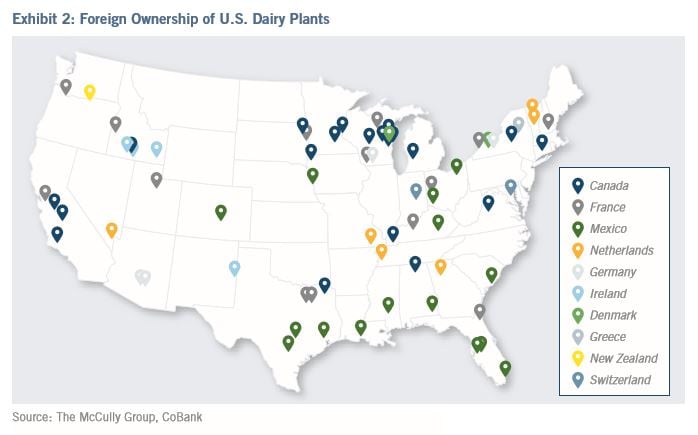Today, approximately 15% of US milk is processed in a plant with at least partial foreign ownership, much of which is from Canadian companies like Saputo and Agropur, CoBank estimated.
According to CoBank, the US has heavily invested in milk production while Europe and other regions that have faced production constraints focused on investment in technology for the processing sector, leading many US dairy companies and international players to capitalize on each other’s capabilities.
“The international dairy industry sees the US milk supply as strong and reliable and they see opportunity in the US consumer,” Ben Laine, industry analyst with CoBank, said.

Benefits and challenges
From a branded product perspective, joint ventures provide an opportunity to diversify product portfolio and gain access to new categories.
The merger between Danone and WhiteWave, forming DanoneWave, is a recent example. While Danone, based in France, already had a strong presence in the US with 34% market share in yogurt, merging with US-based WhiteWave, which held the popular Horizon organic milk brand, gave it a relatively quick path to diversify and gain a presence in the organic market, skipping years of grassroots development.
International JVs provide multiple benefits including a share of start-up costs and reducing risk and costs along the supply chain, with the most successful JVs taking the form of a vertical integration, Laine added.
With vertical integration, the varying roles along the dairy supply chain from raw milk production to manufacturing to marketing are very specialized with minimal crossover.
However, not all international JVs are successful, Laine pointed out, as some fail when the non-managing partner feels market performance expectations are not being met or from a misalignment of goals not addressed during the JV preparation phase.
The strategic partnership between PepsiCo and Müller Quaker, for example, ended two years after building a $200m yogurt plant in New York because of weak sales in 2015.
Other challenges when trying to enter the US market including increased tariff quotas when bringing foreign products into the US and establishing a retail presence, which is why JVs ideally include a dairy company with manufacturing and marketing experience in the US.
More foreign investment to come
CoBank predicts a continued expansion of dairy production capacity in the US, which will provide more opportunities for JV opportunities for the manufacturing, and marketing, of value-added dairy products for the coming years.
Dairy producers and cooperatives will continue to use international JVs for growth instead of incurring the challenges of building and running a plant themselves, Laine said.
Processors will also continue pursuing partnerships with US milk suppliers as an alternative to costly milk procurement in their home regions and to take advantage of companies with branding and marketing capabilities to successfully sell the finished product in the US.
“These partnerships have developed a model for international participation between cooperatives and could potentially open the door for US cooperatives and companies to expand market share outside the US in a growing global market,” Laine said.
